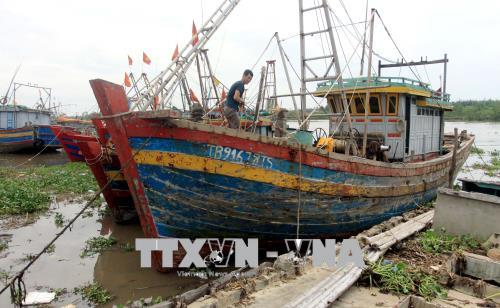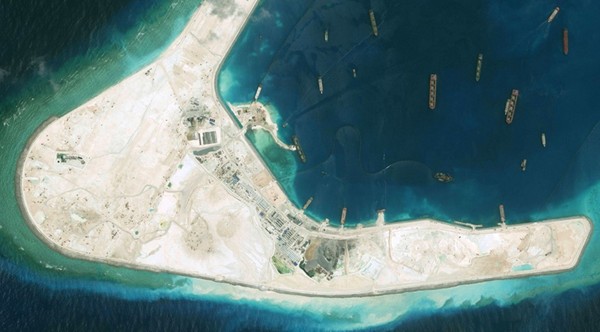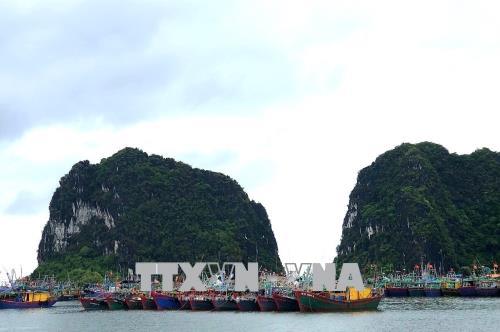 Storm Mulan heads toward northern coast
Storm Mulan heads toward northern coast
Home > Standpoints
Ruling of the century and landmark in the East Sea (part 2)
By VNA 12/19/2017 10:25 |

DigitalGlobe high-resolution imagery of the Subi Reef in the South China Sea, a part of the Spratly Islands group__Photo: DigitalGlobe via Getty Images
Nguyen Hong Thao
Professor Associate in Law
(Continued)
The behavior and actions of China
After having determined that all high-tide features in the Spratly islands generate only a 12 nautical miles territorial sea, the Tribunal easily concluded that there is no overlapping exclusive economic zone of the Philippines and China in the Spratlys. So it can notice easily without any maritime delimitation that the activities of fishermen and law enforcement forces of China beyond the scope of 12 nautical miles from the features listed are located in the exclusive economic zone of the Philippines, “because they do not overlap with any other area that may belong to China.” Action to cross ahead the Philippines’ ships by Chinese law enforcement forces in these waters is a violation of the Convention on the International Regulations for Preventing Collisions at Sea in 1972 and the international conventions on maritime safety. Filipino fishermen have traditional fishing rights in Scarborough as well as Chinese, but China has intervened to prevent Filipino fishermen’s access to the sea.
The Tribunal has asked an independent peer research and concluded the construction of artificial islands on the above-mentioned seven features has caused severe harm to the coral reef and marine environment. In particular, the Tribunal also pointed out that Chinese fishermen have engaged in harvesting endangered sea turtles, coral and giant clams on a large scale in the East Sea, using methods that cause serious damage to the coral reef environment. The Chinese Government is aware of these activities and does not fulfill the obligations required under the Convention to prevent. China’s actions have aggravated the conflict in the East Sea.
Reaction of the parties
The ruling has been well received and widely acclaimed worldwide. The judgment promotes the spirit of respect for international law and gives important guidance on the interpretation and application of the Convention. It requests the countries concerned to clarify the content and scope of claims in accordance with the law approved. The UN Secretary General, the US, Japan, Australia, India, Korea, and many ASEAN member states have quickly issued statements confirming their support of the judgment (1). The ruling is considered final and legally binding. The parties concerned are called to comply with the ruling and to keep restraint and comply with international law.
The award has reduced significantly the disputed waters, clarified the legal status of features in the East Sea, including rocks, shoals and low-tide elevations, and defended the legal status of the exclusive economic zone before the illegal claims based on historic rights. The award gives a new direction to settle disputes through negotiations and other peaceful means in the future. It serves as a precedent for other countries engaged in maritime disputes.
The ruling gives back the freedom of navigation and aviation for the international community on most of the East Sea, and quashes any attempt to set up an air defense identification zone (ADIZ) of any country in the East Sea.
The ruling provides the basis for ASEAN countries with Laos acting as the block’s Chair to get a common position. Singapore, the coordinator of the ASEAN-China relations, the country most concerned about freedom of navigation in the East Sea, and Indonesia, the country liberated from the recent upset when its Natuna islands fall within the nine-dash line, will play a proactive role. Malaysia, assured of James Shoal, will continue its policy of economic cooperation with China with the indirect support of the Tribunal’s award.
The Malaysian Foreign Ministry said that “it is important to maintain peace, security and stability through the exercise of self-restraint in the conduct of activities that may further complicate disputes or escalate tension, and avoid the threat to use or the use of force in the East Sea.” Malaysia cherishes peace and stability of the East Sea and believes that China and all relevant parties can find constructive ways to develop healthy dialogues, negotiations and consultations while upholding the supremacy of the rule of law for the peace, safety and security for the region"(2).
Some countries having no direct interests in the East Sea also see the Tribunal’s judgment as a basis for the parties to continue negotiation-based settlement of disputes. The Philippines have actively initiated a proposal to resume negotiations with China, including negotiations on the issue of “setting aside disputes and pursuing joint development.” The proposal is based on clear legal evidence that all the features in the Spratly islands have no exclusive economic zone or continental shelf individually.
The Tribunal’s ruling also exerts a strong impact on future negotiations aimed at finding a lasting solution to the fundamental issue of sovereignty in the East Sea. Taiwan, the author of the eleven- or nine-dash line, defiant to the ruling for dispossessing of 200 nautical miles claims for Itu Aba(3), may be pleased that the ruling does not affect its sovereignty. The speech of the President of Taiwan onboard a navy vessel sent to the Itu Aba didn’t mention the nine-dash line.
The biggest question is how China will react to the Tribunal’s award. The ruling has prevented the rise of China as a new superpower challenging the US domination as well as her ambitious plan “one belt, one road” and “core interests”. It put Beijing ahead of two options: continue to reject and lose the credibility from other countries or adjust silently its policy in consistence with the award. On the same day of the award, Chinese President Xi Jinping said that China will not accept any proposition or action based on the award, and that China’s territorial sovereignty and maritime interests in the East Sea, under any circumstances, will not be affected by the award(4). China’s Foreign Ministry said the judgment is null and void and has no binding force. No doubt, in the near future China will make a huge propaganda campaign to reject the verdict, maintaining its claims in the East Sea. In the history of international proceedings there were some cases of non-appearance before the international juridical bodies and rejection of jurisdiction such as the Nicaragua vs. US case in 1985 and the Greenpeace Arctic Sunrise ship casein 2013. But with time and pressure from the international community, countries cooperated to settle the dispute under rulings of the Courts or Tribunals. The international community hopes China, the active participant on the United Nations Third Conference on the Law of the Sea, a global power always declaring peaceful rise, will also not make an exception. China’s Foreign Ministry spokesperson announced on 12 July that “the door is open” for new bilateral consultations between the Philippines and China with regard to the disputes(5). The international community should also help China quietly adjust its policies and practical actions in line with international law.
The ruling rejected the nine-dash line in terms of waters claims but did not comment on territorial claims. China will continue to assert sovereignty in accordance with the nine-dash line, maintaining even claim 200 nautical miles exclusive economic zones from features. China will continue to strengthen its military presence on the artificial islands. Beijing can consider the possibility to occupy some uninhabited rocks. A scenario predicted by many experts is that China will carry out land reclamation on Scarborough. Another possibility is not high, but might still occur when Beijing attempts to use force to occupy some positions under the control of other parties. Beijing can argue that the Tribunal is wrong in not considering the Spratly islands as a united entity. Instead of setting up a regional air defense identification zone, which is inefficient and difficult to control, Beijing could declare a baseline around the Spratly islands as it did for the Paracel islands in 1996. From this baseline, China continues to expand the disputed waters, instead of the nine-dash line. China can’t easily give up her attempts to control the East Sea, as a counterbalance to the US’s strategic competition. Struggling for sovereignty in the East Sea will occur fiercely. Local clashes are possible, but the parties will keep cold heads to refrain from war. The reaction of China and the lack of enforcement mechanisms of the Tribunal show that although important, legal solution is not a comprehensive solution for conflict resolution in the East Sea. It makes only a half-way. In the immediate future the situation will be tense.-
[1] https://www.aei.org/publication/reactions-to-the-hagues-south-china-sea-ruling/
[2] M’sia wants
[3]
[4] President Xi says
https://www.theguardian.com/world/2016/jul/12/philippines-wins-south-china-sea-case-against-china
[5] Foreign Ministry Spokesperson Lu Kang’s Regular Press Conference on July 12, 2016, http://www.fmprc.gov.cn/mfa_eng/xwfw_665399/s2510_665401/2511_665403/t1380374.shtml
Photo
 Storm Mulan heads toward northern coast
Storm Mulan heads toward northern coast
 Storm Mulan heads toward northern coast
Storm Mulan heads toward northern coast
 Storm Mulan heads toward northern coast
Storm Mulan heads toward northern coast
 Storm Mulan heads toward northern coast
Storm Mulan heads toward northern coast